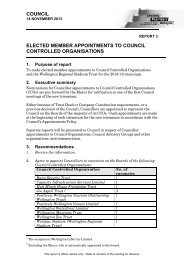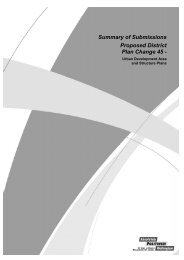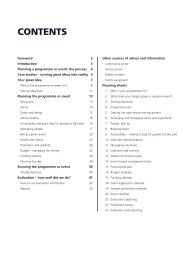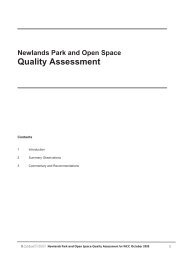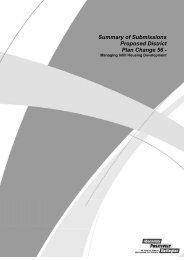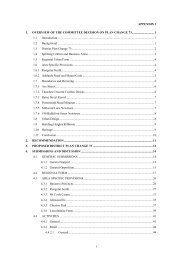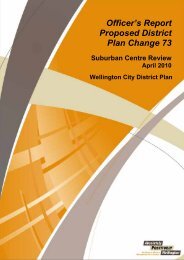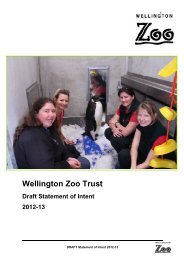part f. open spaces - Wellington City Council
part f. open spaces - Wellington City Council
part f. open spaces - Wellington City Council
You also want an ePaper? Increase the reach of your titles
YUMPU automatically turns print PDFs into web optimized ePapers that Google loves.
F. OPEN SPACES DECEMBER 2012<br />
PART F. OPEN SPACES<br />
CONTENTS<br />
OBJECTIVES 2<br />
F.1 PLANTING 2<br />
F.1.1 Street Planting 3<br />
F.1.2 Ornamental Planting 4<br />
F.1.3 Revegetation 34<br />
F.1.4 Turf 5<br />
F.1.5 Maintenance 5<br />
F.2 NATIVE FOREST AND SHRUBLAND PROTECTION 6<br />
F.3 STREAMS 7<br />
F.3.1 Fish Passage 7<br />
F.3.2 Riparian Buffers 8<br />
F.4 STORMWATER CONTROL 10<br />
F.5 RESERVE TRACKS 10<br />
F.6 CAR PARKING 11<br />
F.7 FENCING 11<br />
F.8 PLAYGROUNDS 12<br />
F.9 RESERVE FURNITURE 12<br />
F.9.1 Seats 12<br />
F.9.2 Reserve Signs 132<br />
F.9.3 Picnic Tables 132<br />
F.9.4 Parks Bins 13<br />
F.10 UTILITY SERVICES 14<br />
1
F. OPEN SPACES DECEMBER 2012<br />
OBJECTIVES<br />
F.1 PLANTING<br />
The object of this section of the Code is to emphasise sustainable integrated<br />
management of the natural environment to ensure resilience to environmental<br />
changes.<br />
The <strong>Council</strong> wants to promote the interrelationship between land and water. Working<br />
with, rather than against, nature. This means setting aside sufficient space for natural<br />
systems to function without the need for mitigation or costly remedies. Natural <strong>spaces</strong><br />
including water bodies are indispensible to life and thus contribute to social values.<br />
Focus is given to habitat protection - maintaining valued landscapes, ecosystems and<br />
habitats and natural features. This includes streams, watercourses and wetlands, and<br />
the protection of aquatic habitats and associated native vegetation.<br />
Retention of landforms, streams –“their margins”- and habitats is important to<br />
sustainability, including the reduction of adverse effects of sedimentation. Retaining<br />
areas of bush and streams is for water quality and quantity reasons as well as<br />
ecological/biodiversity benefit. These areas have the ability to retain flows during storm<br />
event and also filter contaminants out of stormwater. These are the two aims of<br />
stormwater management - reducing flooding and enhancing water quality.<br />
Communities are enhanced through access to <strong>open</strong> <strong>spaces</strong>. Refer to Capital Spaces,<br />
Open Space Strategy for <strong>Wellington</strong> (1998 and currently under review) for<br />
comprehensive information, values and management direction for <strong>Wellington</strong>s <strong>open</strong><br />
<strong>spaces</strong>.<br />
Values associated with Open Spaces can be managed through the protection and<br />
enhancement of <strong>open</strong> space, natural areas, streams and the provision of parks close to<br />
and well connected with neighbourhood centres, in locations that are within close<br />
walking distance.<br />
Please see below for further references to current operative <strong>Council</strong> policy, standards<br />
and documents that must be considered.<br />
All planting must take place from late autumn (May) – early spring (Sept).<br />
2
F. OPEN SPACES DECEMBER 2012<br />
Minimum depth for topsoil is 300mm. This will depend on soil and species to be<br />
planted.<br />
Minimum depth for mulch is 100mm. Mulch is to be of organic material and of<br />
composition that is unlikely to be blown away.<br />
Plant stakes may be required depending on size, type and location of plants.<br />
Any planting next to existing mown grass areas must be marked to avoid damage while<br />
it establishes.<br />
All planting must be a minimum of 1m from existing track edges.<br />
Any development near (i.e. within the drip line), or involving, an existing public tree<br />
must adhere to the <strong>Council</strong>'s draft Working Around Trees document and must not be<br />
carried out without prior approval from councils Parks, Sports and Recreation business<br />
unit.<br />
Failure to observe any of the rules will result in a substantial financial penalty that<br />
increases with each occurrence as per Tree Preservation Guidelines/ District Plan.<br />
Weed control will be required for the first 36 months or until a closed canopy is<br />
established as per clause A.18 Maintenance Period.<br />
Dead plants must be replaced throughout the maintenance period to maintain<br />
vegetation density and achieve canopy closure.<br />
All planting must be supplied and carried out in accordance with horticultural best<br />
practice.<br />
Plants must be eco-sourced from the <strong>Wellington</strong> area and species appropriate to the<br />
area being planted. Professional advice shall be taken where necessary.<br />
Refer also to the <strong>Council</strong> Planting Standard (2012).<br />
F.1.1 Street Planting<br />
Refer to Section C of this Code.<br />
3
F. OPEN SPACES DECEMBER 2012<br />
F.1.2 Ornamental Planting<br />
Ornamental planting is appropriate in some <strong>open</strong> <strong>spaces</strong> in <strong>Wellington</strong> as determined<br />
by parks purpose, use and management. The Open Spaces Strategy, the various<br />
Reserve Management Plans and specific park design or park entrances proposals will<br />
guide appropriate use of ornamental planting.<br />
Any ornamental planting must not threaten indigenous biodiversity.<br />
All planting will be carried out in accordance with horticultural best practice.<br />
F.1.3 Revegetation<br />
<strong>Wellington</strong> eco-sourced native plants must be used for all revegetation. These must<br />
come from a <strong>Council</strong> approved source.<br />
Species will depend on the location and a species list will be approved as <strong>part</strong> of the<br />
landscape plan.<br />
Native species likely to be required are:<br />
Toetoe (Cortaderia fulvida)<br />
Manuka (Leptospermum scoparium)<br />
Kanuka (Kunzea ericoides)<br />
Karamu (Coprosma robusta)<br />
Akiraho (Olearia paniculata)<br />
Ngaio (Myoporum laetum)<br />
Kohuhu (Pittosporum tenuifolium)<br />
Tarata (Pittosporum eugenioides)<br />
Wineberry (Aristotelia serrata)<br />
Koromiko (Hebe stricta)<br />
Mapou (Myrsine australis)<br />
Five finger (Pseudopanax arboreus)<br />
For revegetation areas requiring fire resistant species (‘buffer zones’), planting is likely<br />
to include:<br />
Putaputaweta (Carpodetus serratus)<br />
4
F. OPEN SPACES DECEMBER 2012<br />
F.1.4 Turf<br />
Kanono (Coprosma grandifolia)<br />
Taupata (Coprosma repens)<br />
Karamu (Coprosma robusta)<br />
Kotukutuku, Tree Fuchsia (Fuchsia excorticata)<br />
Hangehange (Geniostoma liqustrifolium)<br />
Papauma/Broadleaf (Griselinia littoralis)<br />
Kawakawa/Peppertree (Macropiper excelsum)<br />
Five Finger (Pseudopanax arboreus)<br />
Poroporo (Solanum aviculare)<br />
Flax (Phormium tenax; P. cookianum)<br />
In-fill planting may be required throughout the maintenance period.<br />
The De<strong>part</strong>ment of Conservation guide Protecting and Restoring our natural heritage –<br />
a practical guide, shall be referenced.<br />
Guidance and approval on ground preparation and mulching must be sought from<br />
<strong>Council</strong>.<br />
The type of grass planted will depend on the use of the area, soil or sand type, irrigated<br />
or not and shaded or not.<br />
Guidance and approval on the varieties and situations in which to be used must be<br />
sought from <strong>Council</strong>.<br />
F.1.5 Maintenance<br />
In addition to the above the Subdivider shall maintain the following aspects of the<br />
works (as a minimum requirement) for a period of 36 months:<br />
a) Grassed areas are to be attended to obtain a good strike,<br />
b) Street trees and street planting – refer to Section C,<br />
5
F. OPEN SPACES DECEMBER 2012<br />
c) Any massed areas of shrubs and trees are to be kept in a healthy state, which is<br />
weed free and the mulch is to be topped up to maintain the specified depth.<br />
Irrigation (temporary and/or permanent) may be required.<br />
d) Any planting is maintained as required by the conditions of a resource consent<br />
or any other agreement with <strong>Council</strong>.<br />
e) Any areas of revegetation or riparian buffer planting are to be kept weed free<br />
and the mulch is to be topped up to maintain the specified depth,<br />
f) Any plant failures/deaths must be replaced throughout the three year<br />
maintenance period. Only established vegetation will be considered compliant<br />
at the end of the three year period and a bond may be taken for newly planted<br />
‘replacement planting’ to ensure establishment.<br />
The above aspects will be inspected for compliance at the end of the 36 month period.<br />
F.2 NATIVE FOREST AND SHRUBLAND PROTECTION<br />
Developers will ensure that natural ecosystems are able to continue to function and are<br />
not degraded or lost as a result of the subdivision or development. Enhancement of<br />
existing natural ecosystems should be considered a priority as a form of mitigation.<br />
Greater <strong>Wellington</strong> Regional <strong>Council</strong>’s document “Managing your bush block; a guide<br />
to looking after indigenous forest remnants in the <strong>Wellington</strong> region” shall be used as a<br />
guide in this matter. Specifications contain clauses adequately covering this<br />
requirement.<br />
Fencing, with approval and guidance from <strong>Council</strong>, should be constructed to exclude<br />
domestic stock. For small forest remnants, this fencing should be placed 5-6 m away<br />
from the forest edge and a protective buffer zone planted.<br />
Pest animal control such as possum, rodent, mustelid, goat or pig control may be<br />
required. Seek advice from <strong>Council</strong>’s Parks and Gardens unit about the best methods<br />
of control.<br />
Weed control may be required if there is a substantial weed problem in the forest<br />
remnant and should be carried out prior to fencing and/or further planting.<br />
Weeds must be carefully identified and advice sought from <strong>Council</strong> for the best<br />
methods of control.<br />
6
F. OPEN SPACES DECEMBER 2012<br />
F.3 STREAMS<br />
Planting to seal off the forest edge may be required. <strong>Wellington</strong> eco-sourced native<br />
plants must be used from a <strong>Council</strong> approved source. Refer to section F1 for<br />
appropriate species.<br />
In some cases where the forest has been severely fragmented and disturbed,<br />
enhancement planting may be required. This involves ‘in-fill’ planting of the forest. Ecosourced<br />
natives must be used, and <strong>Council</strong> will advise of the appropriate species and<br />
locations for enhancement planting.<br />
The <strong>Council</strong>'s Biodiversity Action Plan (2007) states that the natural character of<br />
streams is to be retained wherever possible.<br />
There shall be no piping, straightening or channelling of streams, including ephemeral<br />
streams, watercourses and wetlands unless no other options are available and <strong>Council</strong><br />
permission is granted.<br />
A resource consent from Greater <strong>Wellington</strong> is required in each case. Also a <strong>Council</strong><br />
land use resource consent is required for work within 5m of a watercourse.<br />
Developers can consider the ‘day lighting’ of streams that are now piped to enhance<br />
amenity values and improve water quality.<br />
Ensuring that new culverts are laid below the level of the stream bed and as same<br />
width as channel of the stream.<br />
A riparian native vegetated buffer system shall be created along all perennial and<br />
intermittent streams. The buffer should be clearly marked on plans.<br />
Limits of disturbance of the buffer will be established during application, construction<br />
and post development stages.<br />
F.3.1 Fish passage<br />
The construction of structures such as dams, culverts, erosion control devices, and<br />
stream bed modifications prevent fish from accessing otherwise suitable habitats<br />
upstream.<br />
7
F. OPEN SPACES DECEMBER 2012<br />
Where obstructions including culverts and weirs are deemed necessary, fish passage<br />
must be built to allow fish to climb around the structure. The addition of concrete ‘logs’<br />
in channelled or piped streams to create pools and resting places for fish swimming<br />
upstream must also be included.<br />
Key requirements for fish friendly culverting is reduced water speed, sufficient water<br />
depth, and the prevention of erosion. These can be achieved by applying a minimum<br />
stream bed slope where the culvert is positioned so gradient and alignment are the<br />
same as the existing stream, and ensuring that the culvert is at least as wide as the<br />
stream bed during normal flows.<br />
This will be carried out in accordance with Greater <strong>Wellington</strong> Regional <strong>Council</strong>’s<br />
document “Fish-friendly culverts and rock ramps in small streams”.<br />
For guidance for the construction and retrofitting of in-stream structures to allow the<br />
upstream passage of fish, reference should be made to Auckland Regional <strong>Council</strong>s<br />
document “TP131 Fish Passage Guidelines for the Auckland Region 2000”.<br />
F.3.2 Riparian Buffers<br />
Although reduction of contaminants is a widely recognised function of riparian buffers,<br />
they also contribute significantly to other aspects of water quality and physical habitat.<br />
Habitat alterations, especially channel straightening and removal of riparian vegetation,<br />
continue to impair the ecological health of streams more often and for longer time<br />
periods than contaminants.<br />
Generally, the provision of a 10m minimum buffer width is recommended, with<br />
narrower or wider options being considered appropriate as indicated by site constraints<br />
or opportunities.<br />
For small waterways (or where wider planting is not obtainable) a 5-6 m buffer is<br />
recommended.<br />
For small streams (3 m max width), low stature shrubs and grasses will be<br />
sufficient.<br />
For medium sized streams (6 m max width), small trees (2-4m) are be required<br />
For large streams/rivers (12 m max width) large trees (>4m) large trees are<br />
required.<br />
Species planted must be <strong>Wellington</strong> eco-sourced natives or appropriate species from a<br />
<strong>Council</strong> approved source.<br />
8
F. OPEN SPACES DECEMBER 2012<br />
Riparian planting must occur from late autumn (May) to early spring (Sept).<br />
When choosing plants, consideration must be given to the stream bank substrate and<br />
topography, as well as to the different <strong>part</strong>s of the stream bank e.g. stream edge<br />
(frequently damp, prone to erosion), flood area (stream flat and lower slop prone to<br />
regular flooding), back wetland or spring (areas wet for much of the year), slope (drier<br />
conditions).<br />
Larger plants must be planted away from the stream edge. Shrubs, like manuka and<br />
hebe are suited to the mid bank area, and plants that can cope with wet soils and<br />
occasional flooding, like cabbage trees and toetoe, can be planted near the stream<br />
edge.<br />
Plants should be spaced 0.9 m a<strong>part</strong> and be at least size PB3 or PB5 for planting next<br />
to stream edge.<br />
Appropriate stream edge and flood plain plants (those that are able to lie flat when<br />
flood waters flow over them) include:<br />
Toetoe (Cortaderia fulvida)<br />
Pukio, sedge (Carex secta)<br />
Small swamp sedge (Carex virgata)<br />
Mahoe (Melicytus ramiflorus)<br />
Cabbage tree (Cordyline australis)<br />
Appropriate species to plant for wetland edges or spring areas and slope areas are:<br />
Manuka (Leptospermum scoparium)<br />
Karamu (Coprosma robusta)<br />
Harakeke (Phormium tenax)<br />
Makomako/wineberry (Aristotelia serrata)<br />
Kohuhu (Pittosporum tenuifolium)<br />
Akiraho (Olearia paniculata)<br />
Ngaio (Myoporum laetum)<br />
Toetoe (Cortaderia fulvida)<br />
Cabbage tree (Cordyline australis<br />
9
F. OPEN SPACES DECEMBER 2012<br />
Weed control will be required for the first 24 months or until a closed canopy is<br />
established as per clause A.15 Maintenance Period. Weed control will be carried out in<br />
accordance with Greater <strong>Wellington</strong> Regional <strong>Council</strong>’s document “Controlling problem<br />
weeds in riparian zones: Restore our riparian zones”.<br />
F.4 STORMWATER CONTROL<br />
The <strong>Council</strong> seeks to promote low impact design concepts to stormwater management<br />
to both improve water quality and curb peak runoff volumes.<br />
Sediment and associated contaminants in stormwater can be removed by a range of<br />
treatments, including directing runoff to vegetated swales and infiltration trenches,<br />
through to interceptor and treatment structures These devices capture runoff and<br />
release it at slow rates to filter out contaminants at source and significantly reduce the<br />
effects of discharge into receiving environments. They allow suspended solids to settle,<br />
and in some instances, runoff to be absorbed (infiltrate) through to the ground, thereby<br />
reducing the risk of flooding.<br />
Stormwater must not be discharged to the ground and/or to land sloping down to<br />
receiving waters in a manner that may cause or contribute to ground instability and<br />
erosion.<br />
There are no adverse environmental effects from overland flow.<br />
Consideration will be given to using playing fields and other public <strong>open</strong> <strong>spaces</strong> as<br />
retention ponds (dry or wet).<br />
F.5 RESERVE TRACKS<br />
These are pedestrian accessways that are predominantly for access to reserve areas,<br />
e.g. Town Belt and to create “green networks” for pedestrian connectivity (refer e.g. to<br />
Northern Growth Management Framework). The track network throughout <strong>Council</strong>s<br />
Parks and Open Spaces is extensive and varies in style dependent on use and park<br />
type, character and location.<br />
The <strong>Wellington</strong> city council Open Space Access Plan (2008) should be referenced in all<br />
track proposals. <strong>Council</strong>s Capital Spaces Open Space Strategy for <strong>Wellington</strong> (1998)<br />
and various the Reserve Management Plans (e.g the Town Belt Management Plan and<br />
the Northern Reserves Management Plan) also refer to reserve tracks networks.<br />
10
F. OPEN SPACES DECEMBER 2012<br />
Tracks shall be designed and laid out in accordance with the <strong>Council</strong> Requirements<br />
specified in <strong>Council</strong>s tracks standards and NZ HB 8630:2004 Tracks and Oudoor Vistor<br />
Structures.<br />
Any services in reserves must be buried and follow walking or access tracks except<br />
where otherwise agreed with <strong>Council</strong>s Parks, Sport and Recreation.<br />
Opens <strong>spaces</strong> including playing fields and reserves must allow for access for future<br />
maintenance.<br />
Where soakage is available, and approval granted from the Drainage Engineer and<br />
Parks, Sport and Recreation, consideration should be given to constructing tracks with<br />
a camber so water is directed to vegetated channels.<br />
Lighting will not normally be necessary<br />
The minimum boundary to boundary width for reserve entrances shall be 10m.<br />
F.6 CAR PARKING<br />
F.7 FENCING<br />
Car parks provided in parks and reserves are to be compliant with <strong>Council</strong>’s Roading<br />
Specification.<br />
Where soils, topography and slope permit, run off must drain through permeable or<br />
porous paving or be directed from the car park to rain gardens, swales or similar<br />
vegetated channels. These channels with provisions for infiltration or detention can<br />
either:<br />
Percolate to the ground where capability is available and is satisfactory to the<br />
Drainage Engineer.<br />
Temporarily store run off and release at a slower rate to the public stormwater<br />
system<br />
However overflows from the channel must drain to an approved outfall.<br />
Fencing shall be installed in accordance with approval and guidance from <strong>Council</strong> with<br />
regard for the Fencing Act 1978.<br />
11
F. OPEN SPACES DECEMBER 2012<br />
When adjacent to private property both sides of a pedestrian access track to a reserve<br />
shall be bounded by a fence in a way that retains visual permeability and to maintain<br />
overlook from residential properties. Where there is existing native vegetation at the<br />
boundary fencing may not be required and if required shall be designed and installed to<br />
minimise disturbance and enable vegetation survival and growth.<br />
Gates and bollards will be required where there is vehicle access to reserves. Design<br />
and installation specifications can be obtained from <strong>Council</strong> Parks, Sports and<br />
Recreation.<br />
F.8 PLAYGROUNDS<br />
Playgrounds for public use shall be to the requirements of:<br />
NZS 5828:2004 Playground equipment and surfacing<br />
SNZ HB 5828.1:2006 General Playground Equipment and Surfacing<br />
Handbook<br />
SNZ HB 5828.2:2006 Supervised Early Childhood Facilities playground<br />
Equipment and Surfacing Handbook<br />
All facilities, such as types and sizes of playground fittings, and associated equipment,<br />
are to be consistent with materials used by the <strong>Council</strong> and in accordance with the<br />
<strong>Council</strong> requirements detailed in the Parks and Gardens Specification and <strong>Council</strong>’s<br />
Playground Policy (2002).<br />
F.9 RESERVE FURNITURE<br />
F.9.1 Seats<br />
Reserves furniture must be robust, durable and functional.<br />
All furniture location, design and installation must be consistant with the COucnils<br />
Public Space Design Manual and be approved by the <strong>Council</strong>s’ Parks, Sports and<br />
Recreation unit.<br />
All seats in parks and reserves are to be consistent with materials used by the <strong>Council</strong><br />
and in accordance with the <strong>Council</strong> Requirements.<br />
12
F. OPEN SPACES DECEMBER 2012<br />
F.9.2 Reserve Signs<br />
The seats must be durable and robust<br />
Be weather and vandalism resistant<br />
Have a galvanised frame to minimise rust<br />
Be constructed from Macrocarpa timber so that when timber ages it blends<br />
naturally into the parks environment.<br />
All Parks and Reserves Signage must to be consistent with materials used by the<br />
<strong>Council</strong> and in accordance with the <strong>Council</strong> Requirements and standards.<br />
F.9.3 Picnic Tables<br />
All picnic tables in Parks and Reserves are to be consistent with materials used by the<br />
<strong>Council</strong> and in accordance with the <strong>Council</strong> Requirements.<br />
F.9.4 Parks Bins<br />
Bins in <strong>Council</strong> Parks and Gardens are to be AE Tilley Ltd Horizon Tilting Litter Bin.<br />
Bins in inner-city parks are to be WCC eye-bins. Details of supplier are available from<br />
<strong>Council</strong>s’ Parks, Sports and Recreation unit.<br />
The bins must:<br />
Be lockable to prevent loss of inner sleeve<br />
Be galvanised for longevity – expectation that these assets will last 10 years.<br />
All <strong>part</strong>s of the bins are to be replaceable ensuring low cost maintenance<br />
be no greater than 50 litre capacity.<br />
13
F. OPEN SPACES DECEMBER 2012<br />
F.10 UTILITY SERVICES<br />
All utility services, including reservoirs, shall be placed underground, except where it is<br />
not practicable to do so.<br />
Utility services shall be located so as not to restrict areas useable for outdoor activities<br />
or required for future facilities or tree planting.<br />
Any disturbance of the existing site during installation of a utility shall be made good<br />
immediately after completion.<br />
Requirements of the Reserve Act 1977 and any relevant <strong>Wellington</strong> <strong>City</strong> <strong>Council</strong><br />
Reserve Management Plan must be met when proposing or installing utilities and<br />
infrastructure services in a reserve.<br />
14



